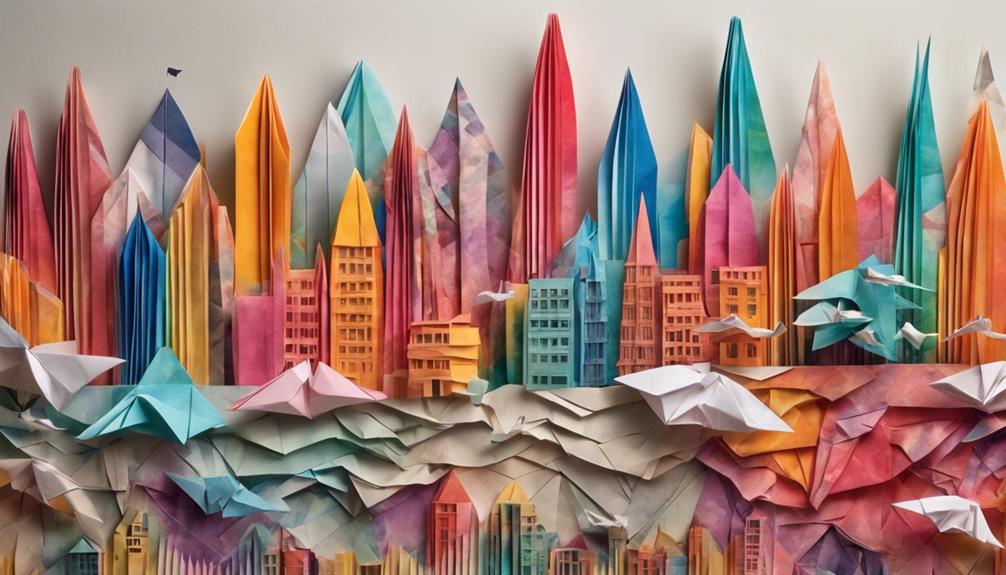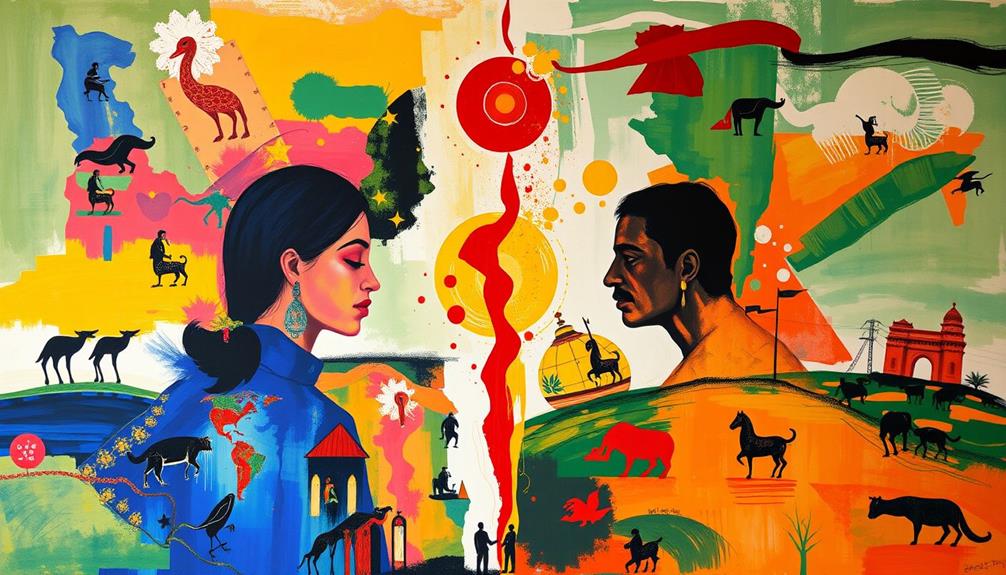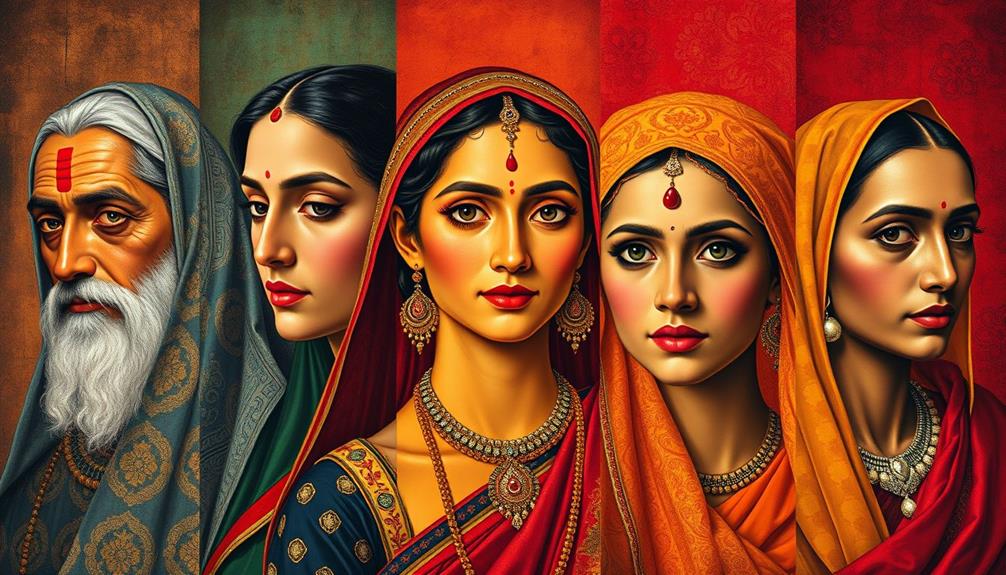Artistic interpretations of survival embody human resilience amidst challenges, illustrating the profound connection between art, nature, and human endurance. Nature's healing power is symbolized through earthy tones and vibrant motifs in art, mirroring human strength in adversity. Artists explore interspecies cooperation, envisioning new futures and interconnected relationships for mutual survival. Art sparks societal change, addressing pressing issues, and advocating for environmental stewardship. Symbiotic art challenges traditional views, portraying innovative survival strategies in a changing world. By examining these powerful art perspectives, one gains insights into the intricate dynamics of survival, offering a deeper understanding of human resilience and interconnectedness.
Key Takeaways
- Art reflects nature's resilience, offering solace and strength in adversity.
- Artists envision posthuman futures through interspecies cooperation and monstrous aesthetics.
- Art catalyzes social change by sparking critical dialogues and addressing pressing issues.
- Symbiosis in art explores survival strategies through interconnectedness and mutual reliance.
- Artists inspire sustainable futures by highlighting ecological crises and advocating for conservation.
The Resilience of Nature in Art
Nature's resilience shines through in art as artists like Alicia Brown skillfully incorporate natural elements to symbolize healing and strength.
This artistic theme of resilience in nature serves as a powerful metaphor for human experiences and the ability to adapt to challenges.
Through the use of natural elements in art, such as earthy tones, flowing water, or vibrant flora, artists depict the enduring strength and transformative power of nature.
These representations not only reflect personal journeys but also emphasize the importance of resilience in the face of adversity.
Imagining Interspecies Cooperation
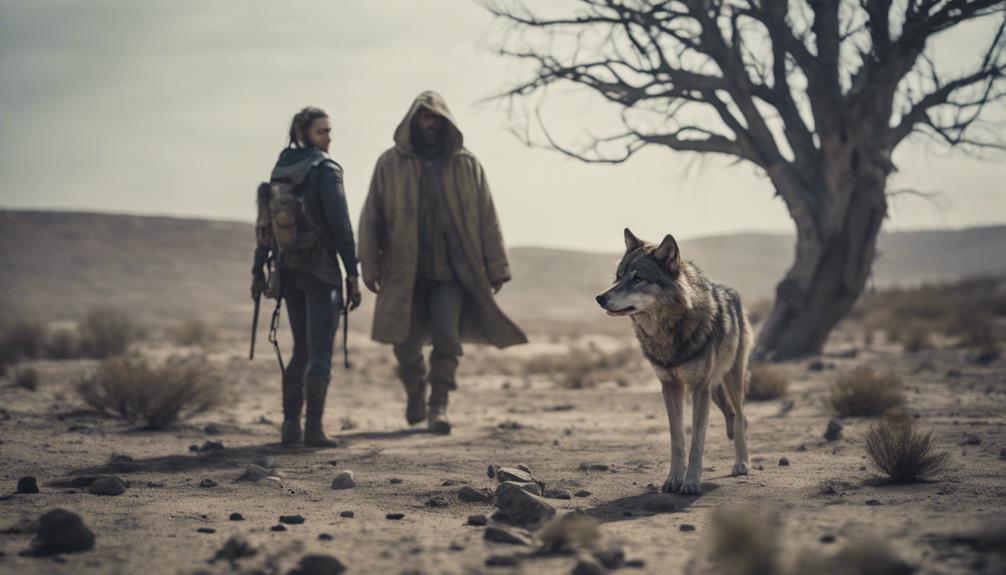
Artists globally explore cross-species relations, envisioning new connections and collaborations in response to perceived environmental crises. Interspecies cooperation in art serves as a platform to reimagine the relationships between different organisms and their environments. By incorporating elements of biology, culture, physics, economics, spirituality, and technology, artists bring forth alternative perspectives on symbiosis between species.
Through biomorphic sculptures that foster symbiosis and landscapes featuring hybrid beings for human adaptation, the concept of interspecies cooperation is vividly portrayed. Additionally, the exploration of posthuman futures through monstrous aesthetics delves into the potential dysfunctions and transformations in the interaction between humans and machines within nature.
The integration of science and technology in artistic representations of interspecies interaction offers insights into the possibilities of coexistence. By showcasing symbiosis between nature and human intervention and proposing bio/techno-hybrid futures through aesthetic experiences, artists contribute to the ongoing dialogue on fostering cooperation between different species for mutual survival and prosperity.
Art as a Catalyst for Change

Art serves as a dynamic force for instigating change by sparking critical dialogues, inspiring action, and fostering resilience in communities facing survival challenges.
Through compelling visual narratives and symbolic representations, artists can ignite societal transformations and advocate for sustainable solutions amidst adversity.
Art for Social Change
Utilizing creative expression, artwork plays a pivotal role in catalyzing social change by shedding light on societal issues and advocating for transformative action.
Artists harness the power of their creations to address pressing matters such as inequality, discrimination, and injustice, sparking critical conversations and inspiring impactful change.
Through visual storytelling and emotional resonance, art engages audiences in reevaluating perspectives and mobilizing for positive societal transformations.
Artistic expressions of resistance, solidarity, and empowerment serve as potent tools in shaping a more equitable and inclusive society.
- Art serves as a catalyst for change by addressing pressing social issues.
- Artists use their work to raise awareness and provoke critical conversations.
- Visual storytelling and emotional resonance engage audiences in advocating for change.
- Artistic expressions of resistance, solidarity, and empowerment contribute to shaping a more inclusive society.
Impactful Visual Storytelling
Amplifying societal narratives through compelling visual representations, art serves as a dynamic force for instigating transformative change. In New York, artists harness the power of impactful visual storytelling to address pressing social, political, and environmental issues.
By using their creative expressions to shed light on these matters, artists spark essential conversations and motivate individuals to take action. Through the use of poignant imagery and symbolism, artists in New York communicate complex ideas and emotions, fostering a deep connection between the audience and the subject matter being portrayed.
The visual narratives crafted by these artists have the remarkable ability to evoke empathy, raise awareness, and provoke critical thinking among viewers. Art as a catalyst for change transcends language barriers, making it a universal tool that drives social transformation and promotes survival strategies.
Through their art, these New York-based artists play a pivotal role in shaping perspectives, inspiring positive change, and fostering a more resilient society.
Inspiring Resilience Through Art
With a powerful ability to evoke emotions and provoke thought, artists inspire resilience through their compelling narratives and symbolic representations.
Art serves as a catalyst for inspiring resilience by addressing social injustices, promoting empathy, and sparking conversations about survival.
Artists use their work to empower communities, amplify marginalized voices, and advocate for change in the face of adversity.
Through visual storytelling and symbolic representations, art encourages individuals to overcome challenges, embrace diversity, and find strength in unity.
Artistic expressions of resilience often reflect personal struggles, historical traumas, and collective resilience in the midst of adversity.
By showcasing stories of survival, resilience, and hope, art has the power to uplift spirits, foster healing, and ignite movements for positive transformation.
The transformative power of art lies in its ability to not only reflect the human experience but also to inspire individuals to persevere, find hope, and stand resilient in the face of challenges.
Survival Through Symbiosis

Exploring the intricate web of mutual dependence, symbiosis in art sheds light on innovative strategies for survival through cooperation and interconnectedness. Artists like Camilla Alberti and Lorenzo D'Alba investigate the concept of symbiosis by portraying the interconnectedness and mutual reliance between different species in their sculptures and landscapes. Their work underscores the significance of cooperation for survival in a world where interdependence is paramount.
Giulia Cenci takes a unique approach by challenging hierarchical distinctions through her hybrid installations featuring disused agricultural machinery. These pieces not only showcase symbiotic relationships but also offer fresh perspectives on survival strategies rooted in collaboration.
Michele Gabriele's art, characterized by chaotic post-technological integrations of organic and industrial elements, reflects the evolving nature of survival tactics in a world undergoing constant change. Luca Petti's dystopian bestiary offers a glimpse into a future where organisms replace humans, prompting contemplation on the adaptive strategies essential for survival through symbiosis.
Through these diverse artistic expressions, the power of symbiosis as a survival mechanism is vividly portrayed, emphasizing the interconnectedness and cooperation necessary for thriving in a complex world.
Rethinking Human-Nature Relationships
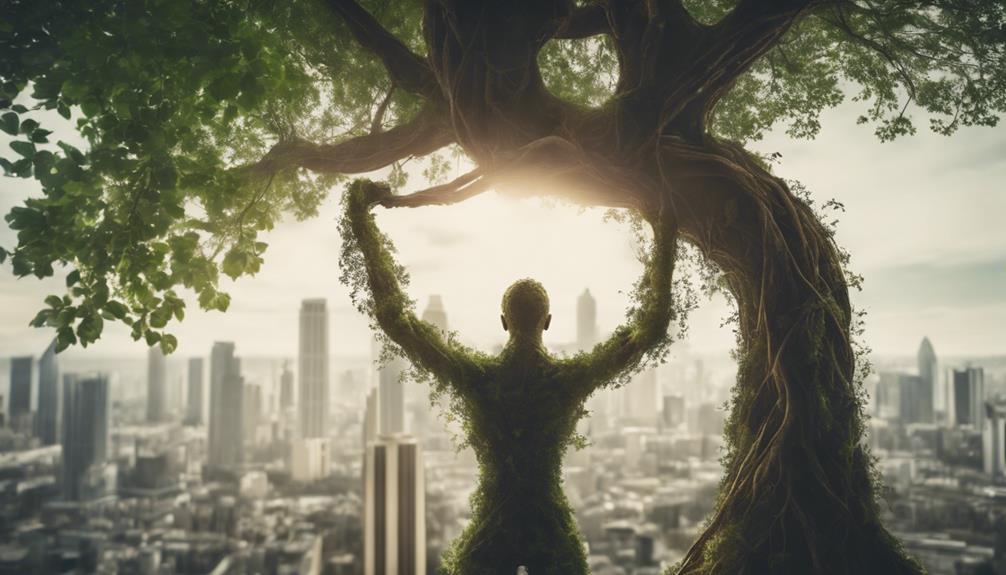
Considering the intricate interplay between humans and nature, artists explore redefining their relationship through various mediums of artistic expression. Alicia Brown, for instance, integrates natural elements into her work to emphasize the healing power of nature and delve into human-nature relationships.
Her art highlights the parallels between human and natural mimicry for survival, showcasing nature's influence on human behavior. Through her paintings, Brown reflects on personal experiences of seeking solace and familiarity in nature during transitions, underscoring the impact of natural elements on human actions and survival instincts.
Moreover, the nature-inspired symbolism in Brown's pieces challenges viewers to reconsider their connections to the natural world and the significant role of nature in shaping human identity.
- Alicia Brown uses natural elements in her artwork to emphasize the healing power of nature.
- Her art explores the parallels between human and natural mimicry for survival.
- Brown's paintings reflect on personal experiences of finding solace in nature during transitions.
- Nature-inspired symbolism in Brown's work underscores the impact of natural elements on human actions and survival instincts.
Ecological Crises in Art

Artists worldwide are actively responding to ecological crises through their artwork, shedding light on the critical need for environmental preservation. Their creations serve as poignant reminders of the pressing issues surrounding climate change, deforestation, pollution, and other environmental perils.
Artistic Responses to Crisis
Amidst ecological crises, artworks globally spotlight the urgent need for environmental action and awareness. Artists from different cultures respond to these crises through their creations, emphasizing the following points:
- Raising Awareness: Art serves as a powerful platform to draw attention to pressing environmental issues such as climate change, deforestation, and biodiversity loss.
- Advocating for Change: Various art forms, including installations and paintings, communicate the critical nature of ecological crises, urging viewers to adopt sustainable practices and support conservation efforts.
- Reflecting Human Impact: Artists creatively depict the consequences of human actions on the environment, sparking conversations and promoting a deeper understanding of ecological challenges.
- Emphasizing Interconnectedness: Through their art, creators highlight the interconnectedness of all life forms, underscoring the significance of preserving nature for the well-being of present and future generations.
Nature as Inspiration
Drawing on the beauty and resilience of nature, artworks convey poignant reflections on ecological crises and the imperative of survival. Artists find inspiration in the intricate ecosystems and diverse landscapes of the natural world, using their creative expressions to shed light on the impact of climate change and environmental degradation. By capturing the essence of nature in their work, they emphasize the urgency of conservation efforts and the need for sustainable practices to protect our planet.
Through artistic representations of endangered species and landscapes, these creators evoke emotions and raise awareness about the interconnectedness of all living beings. The use of nature-inspired art serves as a powerful tool to advocate for environmental stewardship and prompt action towards mitigating the ecological challenges we face. By highlighting the beauty of nature and the threats it encounters, artists contribute to a collective call for preservation and sustainable coexistence with the natural world.
Inspiring Sustainable Futures
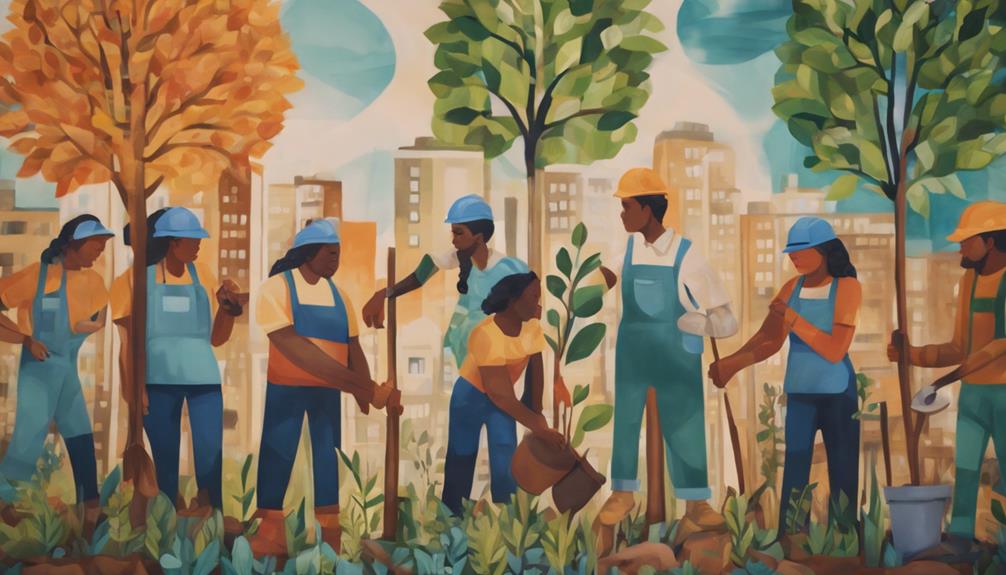
Exploring the intersection of art and sustainability reveals innovative pathways towards inspiring sustainable futures. Artists worldwide are delving into interspecies relations to address environmental challenges and foster sustainable outcomes.
Their work transcends traditional boundaries, envisioning posthuman futures characterized by a redefinition of biological and ontological norms. Through the lens of interspecies perspectives, artists forge alternative connections between various realms such as biology, culture, physics, economics, spirituality, and technology.
This holistic approach allows for the exploration of coexistence between nature and human intervention, proposing bio/techno-hybrid futures that prioritize harmony and balance with the environment. By serving as both shamans and scientists through their art, these visionaries pave the way for new paradigms aimed at ensuring the survival of the planet and its diverse species.
- Artists globally are exploring interspecies relations in response to environmental challenges and the need for sustainable futures.
- Their work envisions posthuman futures through the aesthetics of the monstrous, redefining biological and ontological boundaries.
- Interspecies perspectives create alternative links between biology, culture, physics, economics, spirituality, and technology.
- Through art, artists serve as shamans and scientists, envisioning paradigms for the survival of the planet and species.
The Power of Artistic Vision

Artists' artistic vision serves as a potent catalyst for expressing emotions, ideas, and experiences through diverse mediums. By encapsulating their unique perspective and interpretation of the world, artists harness the power of artistic vision to challenge norms, provoke thought, and evoke strong emotional responses in viewers. This ability to transcend language barriers and communicate complex concepts visually is where the true strength of artistic vision lies. Through their creative lens, artists contribute significantly to cultural discourse, inspiring change and offering fresh perspectives on survival and resilience.
| The Power of Artistic Vision | |
|---|---|
| Key Points | Examples |
| Unique perspective | Personal experiences influencing art |
| Challenging norms | Addressing social issues through art |
| Transcending barriers | Communicating complex ideas visually |
| Inspiring change | Art as a catalyst for societal shifts |
Frequently Asked Questions
What Is the Relationship Between Art and Survival?
The relationship between art and survival is deeply intertwined. Art has evolved as a mechanism for exploring new structures and enhancing understanding to improve survival effectiveness.
The aesthetic brain system, initially evolved for appraising survival objects, now plays an important role in controlling ecosystems through artworks. Artists use metaphors and analogies to address resource issues, selecting useful elements to enhance survival strategies.
The universal appeal of art has greatly impacted human cultural advancement, transforming humanity into a powerful force.
How Does Art Help With Survival?
Art helps with survival by triggering emotional responses essential for decision-making and adaptation in challenging situations. It provides new perspectives to navigate effectively, fosters creativity for innovative solutions, and promotes resilience in adversity.
Metaphorical representations and symbolic vocabularies aid in understanding survival strategies. Incorporating nature in art offers healing, inspiration, and reminds of interconnectedness with the environment.
These aspects collectively enhance survival skills and mental fortitude in trying times.
What Are the 4 Philosophical Perspectives of Art?
The four philosophical perspectives of art are:
Formalism: Focuses on the visual elements and design principles of art.
Expressionism: Emphasizes the artist's emotions and personal experiences.
Instrumentalism: Views art as a tool for social, political, or moral purposes.
Emotionalism: Places importance on the viewer's emotional response to the artwork.
Each perspective offers unique insights into the interpretation and creation of art.
Why Is Art the Most Important Instrument for Survival?
Art serves as the most important instrument for survival due to its unique ability to trigger emotional responses that enhance adaptability and resilience in challenging circumstances.
By tapping into our aesthetic brain system, art provides insights and solutions to complex problems, fostering innovative thinking and metaphorical exploration of new strategies for survival.
Through art, individuals develop essential human skills that complement automation, preparing them for the uncertainties of the future and promoting adaptability.
Conclusion
To sum up, the powerful art perspectives on survival showcased in this article highlight the interconnectedness of nature, humanity, and the environment. Through vivid imagery and thought-provoking concepts, artists challenge us to rethink our relationship with the world around us and inspire sustainable solutions for the future.
By embracing artistic vision and exploring new perspectives, we can work towards a more harmonious existence with nature, ensuring our survival and the preservation of our planet for generations to come.
